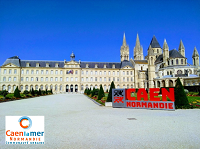Présidents de session
Short presentations
- Diego Gruyer (LPC Caen)
Description
Chair: A. F. Fantina
The emission of the pre-equilibrium particles during nuclear collisions at moderate beam energies is still an open question. This influences the properties of the compound nucleus but also changes the interpretation of the quasi-fission process. A systematic analysis of the data obtained by the FAZIA collaboration during a recent experiment with a neutron rich projectile is presented. The full...
The nuclear symmetry energy indicates the binding energy of the nuclear matter depending on the isospin composition. It is a crucial parameter for the structure and stability of dense nuclear matter which exists in astronomical objects such as the neutron stars. Despite the dedicated efforts for the last several decades using the various collision systems in a wide beam-energy range, the...
Since the advent of nuclear physics, traditional bulk properties such as binding energy, shell correction, and deformations have facilitated the prediction of shell closure near the $\beta$-stability region. However, moving away from the stability region towards the dripline, the isospin-asymmetry (neutron-proton asymmetry) starts to dominate. For enhancing the understanding of this region, it...
The nuclear equation of state (EoS) describes the properties of dense nuclear matter, governing the behavior of nuclei, neutron stars, and energetic astrophysical phenomena.
However, our knowledge of the EoS at high densities remains limited due to the lack of direct experimental constraints.
This study combines the analysis of heavy-ion collision data with Bayesian inference to provide...
The isomeric structure and properties in proton-rich nuclides are crucial for determining the path of the rapid proton capture ($rp$)-process. For example, bound nuclei inside the dripline can have unbound isomeric states and change the $rp$-process pathway. The configuration interaction shell model (CISM) is used to investigate nuclei around the $Z=N$ line at the south-west region of...
We investigate how vector-isoscalar and vector-isovector interactions can be determined within the density regime of neutron stars (NSs), while fulfilling nuclear and astrophysics constrains. We make use of the Chiral Mean Field (CMF) model, a SU(3) nonlinear realization of the sigma model within the mean-field approximation, for the first time within a Bayesian analysis framework. We show...
Giant dipole resonance is a collective excitation mode of the nucleus that exhaust most of the dipole excitation strength. But additionnal low lying dipole strength has been observed in neutron-rich nuclei, called the Pygmy Dipole Resonance (PDR). Both experimental and theoretical studies [1,2,3] have been performed on the PDR, which is often described as the oscillation of a neutron skin...

